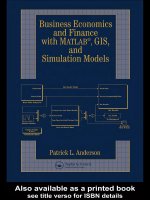Lecture Business economics - Lecture 24: Aggregate Demand and Aggregate Supply
Bạn đang xem bản rút gọn của tài liệu. Xem và tải ngay bản đầy đủ của tài liệu tại đây (10.36 MB, 31 trang )
Review of the previous Lecture
•
All societies experience short-run economic fluctuations around long-run
trends.
•
These fluctuations are irregular and largely unpredictable.
•
When recessions occur, real GDP and other measures of income, spending,
and production fall, and unemployment rises.
Review of the previous Lecture
•
Economists analyze short-run economic fluctuations using the aggregate
demand and aggregate supply model.
•
According to the model of aggregate demand and aggregate supply, the
output of goods and services and the overall level of prices adjust to
balance aggregate demand and aggregate supply.
Review of the previous Lecture
•
The aggregate-demand curve slopes downward for three reasons: a wealth
effect, an interest rate effect, and an exchange rate effect.
•
Any event or policy that changes consumption, investment, government
purchases, or net exports at a given price level will shift the aggregatedemand curve.
Lecture 24
Aggregate Demand and Aggregate Supply
Instructor: Prof.Dr.Qaisar Abbas
Course code: ECO 400
Lecture Outline
1.
Aggregate supply curve
2.
The Long-Run Equilibrium
3.
Causes Of Economic Fluctuations
The Aggregate-supply Curve
•
In the long run, the aggregate-supply curve is vertical.
•
In the short run, the aggregate-supply curve is upward sloping.
•
The Long-Run Aggregate-Supply Curve
– In the long run, an economy’s production of goods and services
depends on its supplies of labor, capital, and natural resources and on
the available technology used to turn these factors of production into
goods and services.
– The price level does not affect these variables in the long run.
Aggregate-supply
The Long-Run Aggregate-Supply Curve
The Aggregate-supply Curve
•
The Long-Run Aggregate-Supply Curve
– The long-run aggregate-supply curve is vertical at the natural rate of
output.
– This level of production is also referred to as potential output or fullemployment output.
Why the Long-Run Aggregate-Supply Curve Might Shift
•
Any change in the economy that alters the natural rate of output shifts the
long-run aggregate-supply curve.
•
The shifts may be categorized according to the various factors in the
classical model that affect output.
•
Shifts arising
– Labor
– Capital
– Natural Resources
– Technological Knowledge
Long-Run Growth and Inflation
A New Way to Depict Long-Run Growth and Inflation
•
Short-run fluctuations in output and price level should be viewed as
deviations from the continuing long-run trends.
Why the Aggregate-Supply Curve Slopes Upward in the
Short Run
•
In the short run, an increase in the overall level of prices in the economy
tends to raise the quantity of goods and services supplied.
•
A decrease in the level of prices tends to reduce the quantity of goods and
services supplied.
The Short-Run Aggregate-Supply Curve
Why the Aggregate-Supply Curve Slopes Upward in the
Short Run
•
The Misperceptions Theory
•
The Sticky-Wage Theory
•
The Sticky-Price Theory
Why the Aggregate-Supply Curve Slopes Upward in the
Short Run
•
The Misperceptions Theory
– Changes in the overall price level temporarily mislead suppliers about
what is happening in the markets in which they sell their output:
– A lower price level causes misperceptions about relative prices.
• These misperceptions induce suppliers to decrease the quantity of
goods and services supplied.
Why the Aggregate-Supply Curve Slopes Upward in the
Short Run
•
The Sticky-Wage Theory
– Nominal wages are slow to adjust, or are “sticky” in the short run:
• Wages do not adjust immediately to a fall in the price level.
• A lower price level makes employment and production less
profitable.
• This induces firms to reduce the quantity of goods and services
supplied.
Why the Aggregate-Supply Curve Slopes Upward in the
Short Run
•
The Sticky-Price Theory
– Prices of some goods and services adjust sluggishly in response to
changing economic conditions:
• An unexpected fall in the price level leaves some firms with higherthan-desired prices.
• This depresses sales, which induces firms to reduce the quantity of
goods and services they produce.
Why the Short-Run Aggregate-Supply Curve Might
Shift
•
Shifts arising
– Labor
– Capital
– Natural Resources.
– Technology.
– Expected Price Level.
Why the Aggregate Supply Curve Might Shift
•
An increase in the expected price level reduces the quantity of goods and
services supplied and shifts the short-run aggregate supply curve to the left.
•
A decrease in the expected price level raises the quantity of goods and
services supplied and shifts the short-run aggregate supply curve to the
right.
The Long-Run Equilibrium
Figure 8 A Contraction in Aggregate
Demand
2. . . . causes output to fall in the short run . . .
Price
Level
Long-run
aggregate
supply
Short-run aggregate
supply, AS
AS2
3. . . . but over
time, the short-run
aggregate-supply
curve shifts . . .
A
P
B
P2
P3
1. A decrease in
aggregate demand . . .
C
Aggregate
demand, AD
AD2
0
Y2
Y
4. . . . and output returns
to its natural rate.
Quantity of
Output
Copyright © 2004 South-Western
A Contraction in Aggregate Demand
Two Causes Of Economic Fluctuations
•
Shifts in Aggregate Demand
– In the short run, shifts in aggregate demand cause fluctuations in the
economy’s output of goods and services.
– In the long run, shifts in aggregate demand affect the overall price level
but do not affect output.
Two Causes Of Economic Fluctuations
•
An Adverse Shift in Aggregate Supply
– A decrease in one of the determinants of aggregate supply shifts the
curve to the left:
• Output falls below the natural rate of employment.
• Unemployment rises.
• The price level rises.
An Adverse Shift in Aggregate Supply









